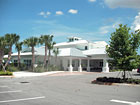
Looking for suggestions on how to make this new school’s HVAC system green, Brad Brown of KAMM Consulting, the mechanical engineer for the developer, approached Charles Eno, sales engineer for Florida Air Conditioning Distributors. Eno proposed a high-efficiency, air-to-air energy recovery ventilation (ERV) to reduce outside air (OA) load - the required rate of heat removal from outside air.
Eno recommended an ERV system that contained an energy recovery wheel (also known as a heat wheel or enthalpy wheel). These help reduce HVAC costs while complying with code-mandated OA requirements. ERV wheels recycle the heating and cooling energy in exhaust air, thereby reducing the load on the HVAC system by as much as 80 percent. This not only translates into significant ongoing cost savings, but also allows the downsizing of HVAC equipment.
The ERV system installed at the school saved approximately $25,000 in construction costs. Since the school opened in the fall of 2009, it has delivered more savings at the rate of approximately $6,000 per year.
CUSTOMIZED SOLUTION
Florida Air Conditioning Distributors recommended ERV wheels manufactured by Airxchange, Rockland, Mass. The company offers a full line of ERV wheels that are sold in integrated packaged systems, as accessories for packaged units, or as ERV options. The company provides energy recovery solutions for 100- to 35,000-cfm HVAC systems.
Florida’s air is usually quite warm and humid; Eno was able to demonstrate that by recovering 70 percent of the school’s exhaust-air energy and recycling it. The ERV system he recommended would allow the architect to reduce the required size of the school’s packaged HVAC unit by one-half. Because ERV would dramatically lower the OA load, the school could get by with a smaller, less-expensive HVAC system.
The ERV system was paired with a high-efficiency unitary air conditioning unit on a single plenum curb to minimize internal duct connections and to simplify the installation on the roof of the school.

UPKEEP
The energy recovery wheel was mounted horizontally, keeping the height of the packaged HVAC system to a minimum and preserving the building’s architectural profile. With the ERV wheel in this configuration, maintenance personnel have an easier time checking its operation and changing filters.
Some energy recovery wheels are difficult and time consuming to clean; contaminant build-up in the wheels can significantly reduce performance over time. This wheel’s lightweight, durable segments (shaped like pie slices) can be more easily removed for cleaning on or off the site. In less than 30 minutes, the manufacturer said, one person can replace all segments with new or previously cleaned spares and return the wheel to service.
If properly filtered, and if the filters are maintained in accordance with the manufacturer’s recommended schedule, energy recovery wheels installed in schools are said to rarely need cleaning.
In effect, downsizing the overall HVAC system paid for the ERV system. In addition, the school saves approximately $500 a month on its utility bill.
AIR QUALITY, HUMIDITY
Humidity is controlled by the school’s HVAC system despite the high intake of outside air. According to Eno, the system manages all of the outside air ventilation for the entire building, conditioning it and feeding it into the returns of all the air handlers.
The air handlers are a part of a building-wide variable refrigerant flow (VRF) system that modulates refrigerant flowing through the coil. This maintains the desired humidity without overcooling the building, and prevents the coil from icing up as well.
Bubli Dandiya, the building’s owner and principal of the new school, stated, “The indoor air quality is excellent. The building is very comfortable, and the air always smells fresh and clean.”
The success of the system at the Turtle River Montessori School has led engineers at KAMM Consulting to make use of this same type of ERV design on several other projects.
For more information, visit www.airxchange.com.
Sidebar: At a Glance
• Location: Jupiter, Fla.
• Completion date: 2009
• Building size: 21,000 square feet
• Building occupancy: 175 people
• Building design load: 45 tons, satisfied by four VRF systems (three 12.5-ton systems and one 8-ton system)
• Outside air flow at design: 7,500 cfm
• Outside air load on a design day: 424,430 Btuh (35.4 tons)
• Outside air load using energy recovery ventilation: 132,000 Btuh (11 tons)
• Total recovered energy: 24.4 tons
• Energy efficiency ratio of the HVAC rooftop unit: 10 EER
• Recovery efficiency ratio (RER) of the energy recovery wheel: 90
• Combined efficiency factor (CEF): 17.8
• Improvement over a cooling system without energy recovery: 70 percent
• Estimated first-cost savings due to unit downsizing: $25,000
• Estimated ongoing savings: Approximately $12,000 per year ($6,000 from the downsized HVAC unit and $6,000 from energy recovery ventilation)
Publication date: 01/31/2011

Report Abusive Comment